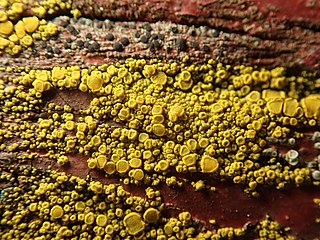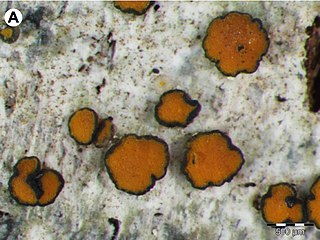
The Teloschistaceae are a large family of mostly lichen-forming fungi belonging to the class Lecanoromycetes in the division Ascomycota. Many members of the Teloschistaceae are readily identifiable by their vibrant orange to yellow hue, a result of its frequent anthraquinone content. The presence of these anthraquinone pigments, which confer protection from ultraviolet light, enabled this group to expand from shaded forest habitats to harsher environmental conditions of sunny and arid ecosystems during the Late Cretaceous. Collectively, the family has a cosmopolitan distribution, although members occur predominantly in subtropical and temperate regions. Although most members either live on rock or on bark, about 40 species are lichenicolous–meaning they live on other lichens.

The Pertusariaceae are a family of lichen-forming fungi in the order Pertusariales.
Agonimia is a genus of lichen-forming fungi in the family Verrucariaceae.

Psoroglaena is a genus of lichen-forming fungi in the family Verrucariaceae. The genus was circumscribed by Johann Müller Argoviensis in 1891, with Psoroglaena cubensis assigned as the type species.

Candelariella is a genus of bright yellow, ocher, or greenish yellow crustose or squamulose lichens in the family Candelariaceae. Members of the genus are commonly called eggyolk lichens, goldspeck lichens, or yolk lichens. The genus was circumscribed in 1894 by Swiss lichenologist Johannes Müller Argoviensis, with Candelariella vitellina assigned as the type species.
Coppinsidea vainioana is a species of crustose lichen in the family Ramalinaceae. It occurs in Europe, where it grows on the bark of pine trees.

Ikaeria is a genus of two species of crustose lichens in the family Teloschistaceae. Both species grow on twig bark of shrubs and trees. It was circumscribed in 2017 by lichenologists Sergey Kondratyuk, Dalip Kumar Upreti, and Jae-Seoun Hur, with Ikaeria aurantiellina assigned as the type species. This lichen was previously placed in the genus Caloplaca, but molecular phylogenetic analysis showed that it belonged in a lineage that was genetically distinct from that genus. Ikaeria serusiauxii was added to the genus in 2020.
Lecanora ussuriensis is a species of saxicolous (rock-dwelling) lichen in the family Lecanoraceae. It is found in single localities in the Primorsky Krai region of the Russian Far East, as well as in Japan.
Opegrapha verseghyklarae is a little-known species of lichenicolous (lichen-eating) fungus in the family Teloschistaceae. It is found in the Russian Far East, where it grows on the thalli and apothecia of the crustose lichen Ochrolechia pallescens.
Lecidella mandshurica is a species of corticolous (bark-dwelling), crustose lichen in the family Lecanoraceae. It is found in the Russian Far East, South Korea, and China.
Lecanora lojkahugoi is a species of saxicolous (rock-dwelling) crustose lichen in the family Lecanoraceae. It is found in the Russian Far East and in South Korea.
Biatora oxneri is a species of corticolous (bark-dwelling) lichen in the family Ramalinaceae. It is found in the Russian Far East and in South Korea.
Oxneria ussuriensis is a species of corticolous, crustose lichen in the family Teloschistaceae. It is found in a single location in the Russian Far East.
Alfred Mycolayovych Oxner was a Ukrainian botanist and lichenologist. His research covered various areas: floristics, taxonomy, phylogenetics, phytogeography, and phytosociology. Oxner founded the National Lichenological Herbarium of Ukraine.
Klára Anna Verseghy was a Hungarian lichenologist. She was the curator of the lichen collection of the Hungarian Natural History Museum in Budapest from 1958 to 1985.
Neobrownliella is a genus of crustose lichens in the subfamily Teloschistoideae of the family Teloschistaceae. It has five species. The genus was circumscribed in 2015 by lichenologists Sergey Kondratyuk, Jack Elix, Ingvar Kärnefelt, and Arne Thell, with Neobrownliella brownlieae assigned as the type species. It is a segregate of the large genus Caloplaca. Characteristics of Neobrownliella include a thallus that is continuous or areolate, the presence of anthraquinones as lichen products, a cortical layer with a palisade paraplectenchyma, and the lack of a thick palisade cortical layer on the underside of the thalline exciple. Two species were included in the original circumscription of the genus; an additional three species were added in 2020.
Bryostigma epiphyscium is a species of lichenicolous fungus in the order Arthoniales. Formerly classified in the genera Arthonia and Conida, it was transferred to the genus Bryostigma in 2020.
Bryostigma is a genus of lichen-forming fungi of uncertain familial placement in the order Arthoniales. The genus was circumscribed in 1979 by Josef Poelt and Peter Döbbeler, with the muscicolous lichen Bryostigma leucodontis assigned as the type species. A dozen Arthonia species were transferred into the genus in 2020 following molecular phylogenetic analysis of the family Arthoniaceae that showed distinct phylogenetic lineages that were basal to that family. The genus contains several parasitic species that occur on hosts having chlorococcoid photobionts.
Gyalecta ancistrospora is a species of saxicolous (rock-dwelling), crustose lichen in the family Gyalectaceae. Found in Korea, it was formally described as a new species in 2014 by lichenologists André Aptroot and Kwang-Hee Moon. The type specimen was collected by the first author from Mount Juwang at an altitude between 330 and 520 m ; there, it was found growing on siliceous rock. It is only known to occur in this area, where it grows on boulders shaded by trees in forest.

Verseghya is a genus of lichen-forming fungi in the family Pertusariaceae. It has two species. The genus was circumscribed in 2016 by lichenologists Sergey Kondratyuk, Laszlo Lőkös, and Jae-Seoun Hur, with Verseghya klarae assigned as the type species. This crustose species is found in South Korea, where it grows on the bark of a wide variety of both deciduous and coniferous trees. Molecular phylogenetic analysis showed that Verseghya klarae occupied a separate phylogenetic branch in the Pertusariaceae, situated between the genera Ochrolechia and Pertusaria and the Lecanora subcarnea species complex. Verseghya thysanophora was transferred to the genus in 2019. It is widely distributed in the Northern Hemisphere.





